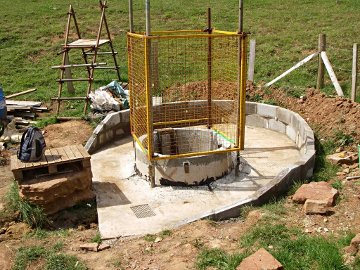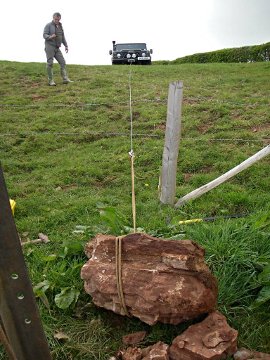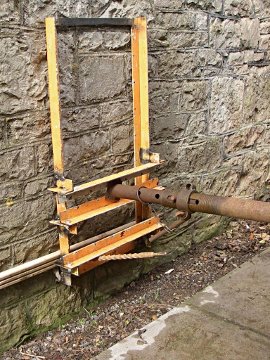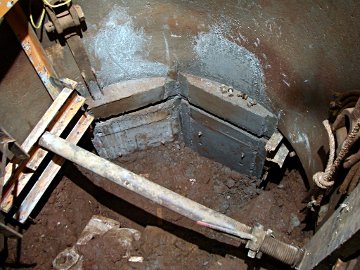Belfry Bulletin 541, 58(4), September 2011, p18-22
'Progress' at Home Close Hole
Part Two, January 2010 - April 2011
Tony Audsley
Now when a miner discovers a vena profunda he begins sinking a shaft and above it sets up a windlass, and builds a shed over the shaft to prevent the rain from falling in, lest the men who turn the windlass be numbed by the cold or troubled by the rain. The windlass men also place their barrows in it and the miners store their iron tools and other implements therein.
Georgius Agricola, De Re Metallica. Book V.
In the last BB article about Home Close Hole, (BB 534), the word progress in the title was flanked by double quotation marks. This time it is just in single quotes, so we are probably getting somewhere at last. The problem with the work at this site is that, like an iceberg, most of it is hidden away and apparently pointless, but the hidden part is necessary to support the little bit that is visible on the surface.
I think that some of this infrastructure work needs a little explanation, because the rationale behind it is not always immediately obvious. Unfortunately, it is a bit problematical to write a coherent account of the work because several of these tasks were running concurrently and they all got rather tangled together, so I'll deal with the projects individually and go light on the chronology. Anyway, enough of that; what were the problems? Basically, just four:-
- An unstable and fragile shaft.
- Water.
- A LOT of spoil to be removed.
- What to do about shoring when digging down.
This article deals with 1 - 3, we'll start to think about number 4 when we get that far. In the first stage of the dig, we had excavated a rift, may be sixish metres long by threeish metres wide. The dimensions are guesstimates, because we never saw all of the rift at any one time, but they are the right order of magnitude. This rift was too wide to support the concrete rings, so the shaft was installed close to the rock wall but without any sort of foundation. At the time I was full of misplaced optimism that this could easily be fixed.
Now the pipes used are 1.200 metres internal diameter with a wall thickness of 100 mm. A ten metre stack of these pipes weighs rather over 10 tonnes and ours was sitting on a foundation of just a shade over 0.6 sq metres in area. In effect, it could be likened to a gigantic pastry cutter. This was compounded by the fact that the majority of the water falling onto or flowing into the depression drained down the outside of the concrete shaft. This destabilised the shaft by washing material away from it and turned the fill at the bottom into slurry.
Now, we needed to tunnel under this fill in order to reach the solid rock to the north and the west of the shaft. The shaft could then be pinned to this and all would be wonderful. Our problem was that we could not tunnel under the fill. A civil engineering firm faced with the same problem could freeze the ground and then treat it as solid rock, do the excavation and then install iron or concrete tubbing. Lucky them to have unlimited funds. We had two alternatives, either to give up or to get the fill dry enough to tunnel under it.
The first stage was to drain and dry out the depression and this has been outlined in detail in the last article. Unfortunately, however, although this did make the fill a lot drier, it was still too wet to handle. The problem was that water also flowed from the area to the north of the depression and sank round the shaft. We needed to fix this as well, so starting around the beginning of May and continuing through to August, we excavated an area around the top of the shaft and then cast a segmented concrete apron or pit-head around the shaft and built a two course blockwork wall on the north to control water running off the field. Water running into this pit-head area, apron, patio, call it what you will, was fed by a drain to the sump in the middle of the depression and then from there piped down the inside of the shaft to debouch below the level of the concrete rings.

The shaft with its waterproofing.
Incidentally, the word 'patio' originally referred to a paved area at a (Spanish) mine where silver ore was treated by the Patio Process in which mercury was poured on the ore and the mixture then trampled by horses to aid amalgamation. Nowadays, it refers to a place to consume burgers and the like, which probably carries equivalent health risks. On both counts though, it is an appropriate name for the Home Close structure.
During the construction of this patio, we had to remove some large boulders from the area of the shaft and Jeff thought that the electric winch on his Land Rover would be good for this. Now, this winch has a cunning remote control device allowing Jeff to operate it from outside the Land Rover. So, he parked the Rover at the top of the slope, we hitched up the cable to the boulder and Jeff pressed the tit on the remote control. For a while all went well, but unfortunately, Jeff happened to be standing in front of the Rover and watching the boulder just when the Land Rover decided that it would be fun to run over its owner. So it started off down the slope towards him. We were worried that the Land Rover might damage the site fence after it had squashed Jeff, so we yelled a warning.

Jeff just before the Land Rover
tried to run him over.
Well, that brightened the day up nicely. We went on to cast a reinforced concrete ring on top of the shaft to level it and then fixed four upright scaffold poles round the shaft to act as a headframe. This was eventually cross braced, then fitted with a traversing mechanism to slide a full kibble away from the shaft. (May - September).
It was obvious from the beginning that this dig would consume a large amount of concrete. We had already taken delivery of 10 tonnes of aggregate, but we also needed a dry store for cement. In addition, we needed to house a power winch. Now, this might be wimpish, but the knowledge that the stream was some 100 metres below the depression and the thought of all that fill in between produced a sinking feeling in the pit of the stomach. I have done my fair share of hand winching over the years and, strangely, have never managed to grow to like it. So, as a concession to old age and infirmity, a power winch it had to be.
So, moving swiftly back in time, January 2010 saw the start of the construction of a 'flat pack' digging hut/engine house/cement store in our garden at Cheddar. At the same time, we started pinching spoil from Caine Hill to act as foundation for the hut. Work on the hut at Cheddar continued on and off until mid May, when it was dismantled, stuffed into the Land Rover, taken to the dig and re-erected, 14-15th May.
Over the same period, I developed a deep but emotionally scarring relationship with the old Wigmore winch, which had lain neglected and unloved in the Stone Belfry for many years until its eviction. Many of the details of this relationship are rather too painful to recall but in outline involved trying the original engine and rejecting it as useless, working on a replacement, originally from Mike Thompson, and failing miserably, trying a Briggs and Stratton (ditto) and finally returning to the original. This needed: valve seats re-cutting then grinding in, new magneto coil, new points and condenser, new jets for the carburettor. Finally modifications to the exhaust so that it vented to the right, out of the hut rather than to the left, into the hut as originally made. OK, that's the engine done, let's just have a quick look at the winch itself. This turned out to be a triumph of British engineering of the 1950's at its worst. There were four ball bearings in the winch mechanism and it was impossible to lubricate any of these without totally dismantling the machine. Consequently, all bearings were dry, rusty and seized. They had been turning on their shafts for some time. Enough - come 4th June it was the proud possessor of refurbished bearings fitted with four shiny new grease nipples.
While power winches take the effort out of hauling, they do have the disadvantage of insensitivity. In the event of a snag, the winch will continue to turn until the kibble tips over or something breaks, neither being good for the bod at the bottom of the shaft. Although the Home Close shaft started out very nearly vertical, this was no longer the case and there was a danger of the kibble catching on the fixed ladder. To prevent this, a guide cable was fitted on the opposite side of the shaft and the kibble could be attached to this via a running pulley. Good idea - but ...
... the digger would now have to lean so far over the shaft in order to detach the kibble that they were quite likely to take a header down the shaft in the process. Several rather hair-brained attempts were made to get round this problem, but eventually in October, hinged wooden doors were fitted to the top of the shaft. Problem solved.
I know that this is going on a bit but if you think this is boring to read, you should have tried doing it; I'm leaving a good half of it out. But we are getting closer to the exciting bit - promise. Wind back once again to February, when work started on a device to support the fill and act as shuttering for concrete foundations of the shaft. I guess that device does require a bit of explanation. The problem with digging below the rings had always been that the fill collapsed, either from above or from the sides; usually both. We needed to be able to hold the fill up, dig a space underneath, then install shuttering and get in reinforcing and concrete before the house of cards collapsed. Collapses cause voids behind the concrete rings and voids behind the rings are very definitely A BAD THING because they unbalance the compression forces on the ring which can cause it to fail. Something to be avoided then.

The drilling jig.
The piece of wood indicates
the position of the bottom
of the shaft when in use
The ACME Miracle Digging Shield is a two part device, welded up out of old bed frames. The frame is clamped in position at the bottom of the shaft using an Acrow prop against the opposite wall. There is a cross-bar at the bottom of the shield, just below the bottom of the concrete ring. As many metre long rebars as it is possible to get in are hammered into the fill just above the level of this cross-bar. The cross-bar supports the outer ends of the rebars and the rebars support the fill above. As quickly as possible, the space below the shield is excavated. 450mm (ish) horizontally, 600 mm (ish) vertically.
As quickly as possible, the second part of the shield is installed. Angle iron bars slide down from the frame work of the shield on the left and right of the excavated space, then side cheeks, which angle out at 22.5 degrees (I mean it!) are bolted to these. Once the bolts are in, the top and sides of the void are supported.
Take a breather: then fit 10mm reinforcing bars, the hooked ends of which protrude through slots in the side cheeks. These will connect to the neighbouring block. Then fit the front panel, held in by wooden wedges. Then shovel in concrete until full. This usually takes 4 to 5 mixer loads.
This completes one section of underpinning. If the calculations are right, eight such sections should produce an octagonal foundation or elephant's foot under the shaft. Some of these sections will have been attached to the rock walls behind.
Construction of the shield was completed by late March and so there was nothing for it but to get underground and use the ruddy thing.
On 2nd April, Alice and I took the shield to the dig to try it for size. In the event, it didn't quite fit and would need some minor modifications, so we cleaned out all the detritus that had accumulated at the bottom of the shaft and hauled it out with the power winch. During the clearing process, I noticed a faint but definite DRAUGHT in the fill at the base of the ladder. This was later verified by Chris Batstone using a smoke pellet.
On Wednesday 6th April, Les Oxborough, Alice, Rosie and I, along with Tula the Jack Russell, installed the digging shield in position at the bottom of the shaft and secured it with an acrow then drove in as many 1 metre lengths of rebar as possible to act as temporary supports for the fill. The fateful day came the following Saturday when as the log says:-
It had to come at some stage, I suppose; we have actually started digging! Chris Batstone, Dave Garman, Phil Romford and Tony Audsley all took turns in digging at the bottom of the shaft [...] We all found the work area extremely constricted as the acrow support divided the 1.2 metre shaft into two and the kibble took up more that its fair share of space on one side of this. Eventually we settled on filling sacks, stacking them, then hauling them out in batches of three or four per kibble.

The digging shield in position
ready for segment number three.
To mark the first day of digging, we had a BBQ at mid-day and sat round in the sun drinking beer afterwards. It was a successful day, we hauled 19 kibbles out (about three standard digging bags per kibble) and the winch, traverse and tipping system all worked well. The digging shield was much more difficult to handle underground than on the surface, but this did improve with practice. The following Monday, Alice, Tony, Les and Rich Witcombe sent five mixer loads of concrete down the shaft. The work on the first segment was finished on Sunday 17th April when Trevor Hughes put in the last mixer load to bring the concrete up the the level of the base of the pipes.
So the first segment took three days to complete. Fortunately we improved with practice and the next two segments were completed in a day, excavation in the morning, mixing and pouring in the afternoon. These were long days though, starting shortly after 1000 and continuing until 1800, but they got the work done.
The state of the dig at the end of April is that three concrete segments have been completed and 5 more are required to complete the underpinning.
In case you didn't notice, you have just read through the exciting bit that I referred to earlier! That's it for now. Next time, with any luck, you may get an account worthy of the title progress, there is even the possiblity of an exclamation mark!
Statistics:
From January to December 2010, there were 204 entries logging work on or at the dig.
From January to April 2011, there were 59 entries logging work on or at the dig.
From 2nd April until 29th April, 34 kibbles of spoil were hauled out and 14 mixer loads of concrete went down the shaft.
Diggers, helpers and visitors:
Alice Audsley, Ben Selway, Bill Combley, Chris Batstone, Chris Harvey (Zot), Clive North, Duncan Butler, Henry Bennett, Henry Dawson, Ian Gregory, Jeff Price, John Williams (Tangent), Les Oxborough, Mark Denham, Mike Weadon, Mike Wilson, Nick Winter, Phil Romford, Rich Witcombe, Rosie Audsley, Sam Batstone, Stu Lindsay, Tim Large, Tony Audsley, Tony Dingle, Trevor Hughes, Tula, Vern Freeman.
Some of these came lots of times, some only came once, but I think that everyone enjoyed themselves at least some of the time, which is what matters.
Page Created: Thu Apr 12 2012
Revised: